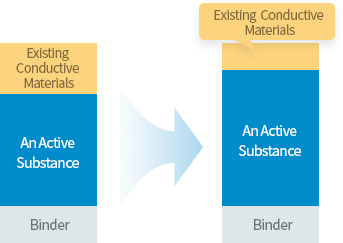Products & Technology
-
Data : Meritz Securities Research Center
-
Data : Shinyoung Securities Research Center
-
Data : Korea Investment & Securities Research Center
3,000 times in 2025
-
Battery Configuration
-
Battery Configuration 4 components of a lithium-ion battery
-
Electrode Configuration
-
Changes in conductive materials for increasing energy density
Carbon Black → CNT → Graphene Conductive materials are materials for improving the conductivity of lithium oxide and improving the performance of lithium secondary batteries Currently, carbon black is mainly used as a conductive material Graphene should be replaced to improve the charge/discharge life of energy density Domestic battery manufacturers use CNTs only for some IT products In the future, the capacity should be doubled or developed with graphene when using a 5G networkUse Graphene
 Use fewer conductive materials than conventional conductive
Use more active substances
Use fewer conductive materials than conventional conductive
Use more active substances Increase in charging an amount
Increase in charging an amount
-
Lithium-ion battery companies target electric vehicles
Increase more active material to increase travel distance once charged
If a lot of active substances on the anode are inserted, it gets clogged and you have to put a conductive material
Graphene allows only 20% of conventional conductive materials
5 times more energy density than conventional conductive materials Conductivity is more than 10% higher than conventional conductive materials Reduce charging time
Lithium-ion battery companies target electric vehicles
Reduce charging time
Lithium-ion battery companies target electric vehicles
-
Cell pouch film
-
Lithium-ion battery
-
Electric Car
-
Key Issues about Current StructureCurrent Structure

Low physical strength as a case
Low breaking strength due to torsion
Low penetration capability during penetration experiments
Deformation of Cell Pouch Film by Time Change
Creak of edges and corners generated during forming
-
Graphene FILM Structure Advantages/TasksGraphene FILM STRUCTURE

Changed 4 times the base process adhesive layer to the graphene film
Application of properties such as strength(steel X 200 times), thermal conductivity(more than diamond X 2 times), and elasticity of graphene (not losing electrical properties even if bent)
Deformation of Cell Pouch Film by Time Change
Improvements such as low physical strength, fracture strength, low penetration capability, deformation, and creak are expected.








